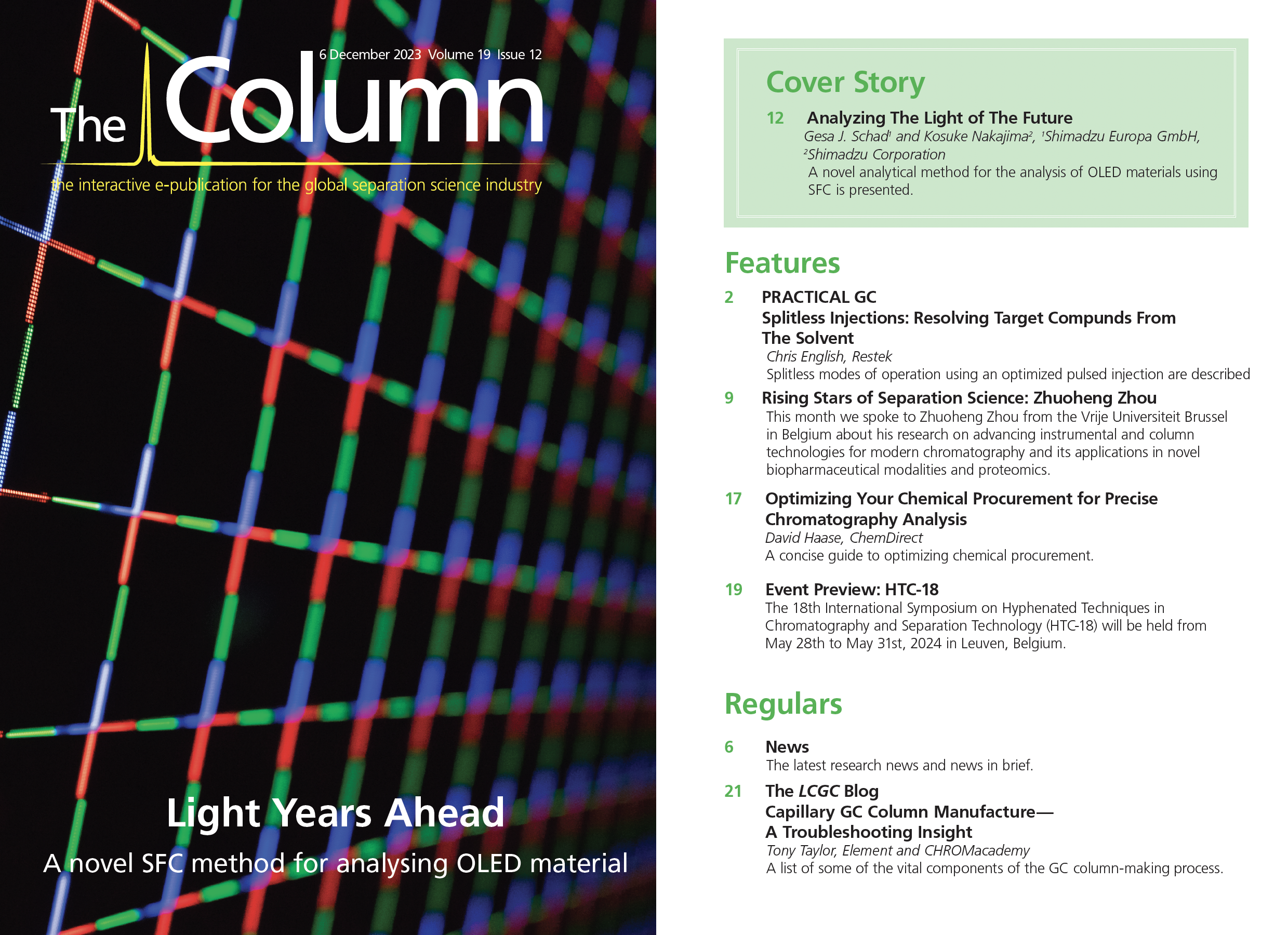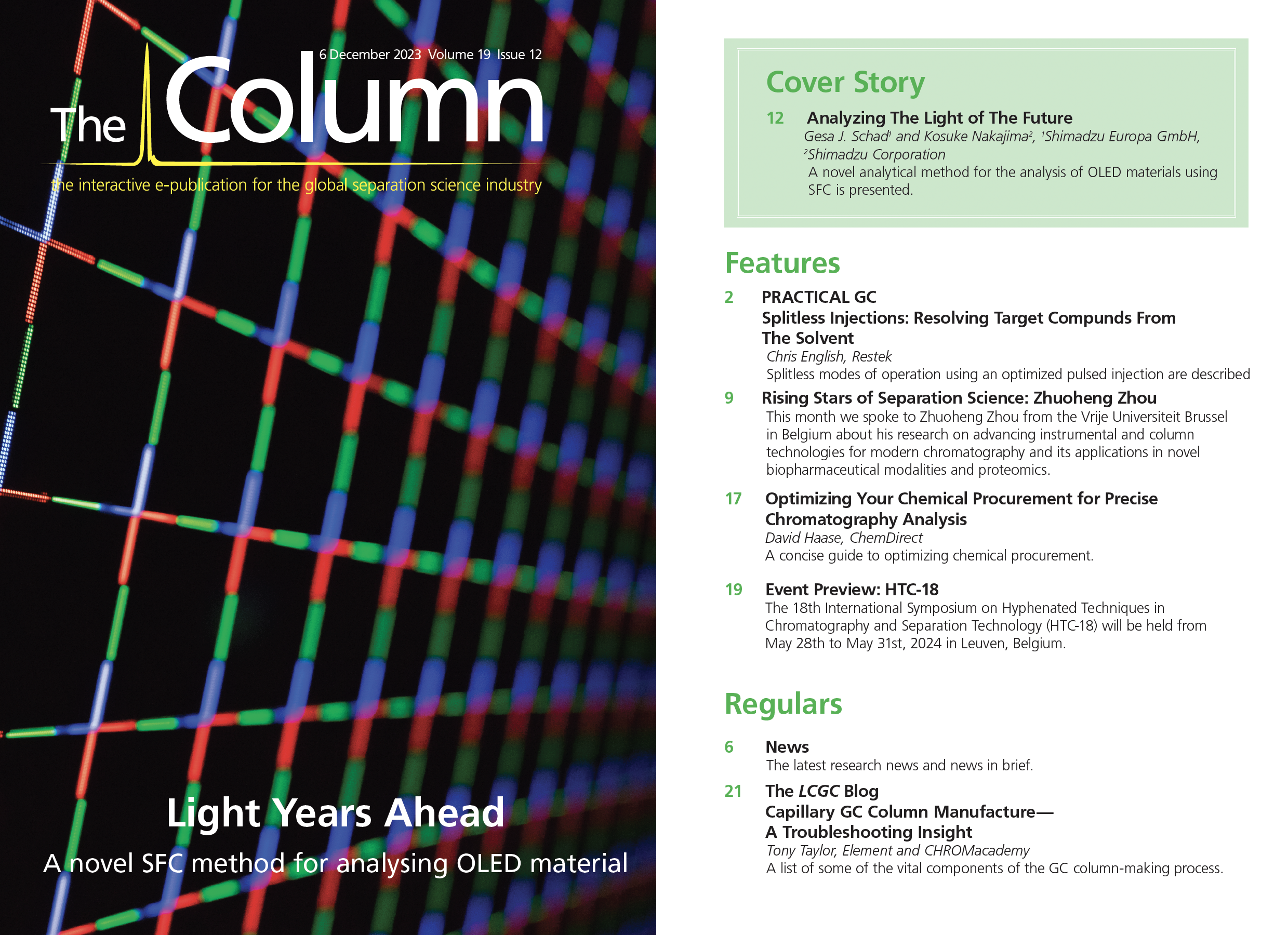Splitless Injections: Resolving Target Compounds from the Solvent
The use of split injection minimizes analyte breakdown, reduces solvent on the column, and produces sharp Gaussian peak shapes. The drawback of this technique is the loss of sensitivity, as only a small percentage of the sample reaches the analytical column while the remainder of the analyte is vented. The use of splitless injection allows most of the sample to reach the column. The disadvantage of this technique is solvent interference with target compounds and analyte breakdown in the inlet. This article will detail splitless modes of operation using an optimized pulsed injection.
Split and splitless injections introduce the sample into a heated injection port as a liquid where it is rapidly and completely vaporized along with the analytes in the sample. The vaporized sample condenses at the head of the column along with the solvent. In split injection mode, only a small amount of the vaporized sample is transferred onto the head of the column; the remainder of the sample is removed via the split vent line. The use of split injection minimizes analyte breakdown, as compounds spend less time in the hot injection port; however, loss in sensitivity is observed because much of the sample exits the split vent line. In splitless injection, the split valve is closed long enough to allow most of the vaporized sample and solvent in the injection port liner to be transferred to the analytical column; this can take anywhere between 30 and 90 seconds. As the split vent valve is closed, the sample transfer moves at the speed of the column flow—typically in the 1–2 mL/min range (1). Solvent focusing in splitless mode requires an oven temperature 20 °C below the boiling point of the sample solvent, thereby allowing the solvent and the analyte to condense and wet the stationary phase. One exception is analyte focusing, which can be performed if the difference between the analyte boiling point and solvent boiling point is 150 °C (2). There are many analyses that use solvents and volatile organic compounds (VOCs) where solvent focusing and analyte focusing are not possible. This article will evaluate different solvents and compounds that cannot easily be analyzed using classical splitless injection and evaluate pressure pulse injections.
Silhouette of businessman holding target board on the top of mountain with over blue sky and sunlight. It is symbol of leadership successful achievement with goal and objective target. | Image Credit: © Dilok - stock.adobe.com

Experimental Design
A 30 m × 0.25 mm, 0.25-μm (Restek) XLB-type column was used with the following oven program: 35 °C starting temperature with a hold time of 4 min followed by a 35 °C/min ramp to 330 °C with no final hold time. Analysis was performed using an Agilent gas chromatograph mass spectrometer (GC–MS) with a scan range of 35 to 550 amu. Seven different methods were performed as follows: 5:1 split analysis, splitless 1 min hold time, splitless 0.5 min hold time, splitless 0.25 min hold time, splitless 0.15 min hold time, pulsed splitless 30 psi pulse 0.64 min hold 0.59 min, and pulsed splitless 30 psi pulse 0.64 min hold 0.64 min. In addition, other pulsed splitless conditions were evaluated and are briefly
mentioned in the results and discussion section.
Pyridine and 1,4-dioxane were made up at a concentration of 10 ppm in both methylene chloride and methanol individually. They were also made up in methylene chloride and separate standard mixes spiked with 2% methanol, 2% benzene, and 2% 2-ethoxyethanol (EGEE) to evaluate the effects of co-solvents on the standards under different injection port conditions.
Results and Discussion
The first interesting observation is the shift in retention of the analyte related to the amount of solvent entering the column. 1,4-Dioxane eluted at 3.50 min under split conditions where a 5th of a microlitre of methylene chloride was injected onto the column. Because the amount of solvent on-column increased (increase in hold time), the retention also increased, with the most retention occurring for peak number four in Figure 1, which had a retention time of 3.83 min. This phenomenon was documented in a 2021 article in The Column, which described increases in retention even when switching from a 200:1 split to a 25:1 split (3). In addition, in splitless mode it requires more time to transfer the analytes from the injection port to the head of the column. The split analysis, not surprisingly, produced good peak shape and lower response compared with the splitless injections. As the boiling point of methylene chloride is 40 °C, we were unable to perform a splitless injection 20 °C below the boiling point of the solvent without cyrogenic cooling. Analyte focusing will be unsuccessful because 1,4-dioxane’s boiling point is 101 °C, which is less than the 150 °C difference in boiling points between the solvent and analyte needed for the technique. Performing a classical splitless injection with a 1-min hold time resulted in split and tailing peak shapes. Only the splitless hold time of 0.15 min produced an acceptable peak shape, with an area 2.5× that of the 5:1 split analysis. Splitless pressure pulses with a 70 psi pressure pulse were evaluated and resulted in no analyte response because the 1,4-dioxane and methylene chloride coeluted. Using previously published optimized splitless pulse conditions produced the best results (4). A slight adjustment to the hold time during the pulse did not change the results, although it is important to remember that the hold time should be the same or less than the pulse time to prevent excessive amounts of solvent from entering the column. Tony Taylor’s LCGC Blog details many other factors for the optimization of pressure pulse injections (5). Pyridine and 1,4-dioxane in methanol were analyzed and none of the seven methods produced acceptable peak shapes, with the longer splitless hold time methods producing smeared peak shapes. This was most likely a function of polarity and a higher boiling point for methanol (65 °C) compared with methylene chloride (40 °C).
Figure 2 is the result of using optimized splitless pulse conditions and evaluating cosolvent combinations for method robustness. Ideally the small amount of additional solvents should work for the analysis. Even at low percentage levels (2%), EGEE caused peak distortion because the 1,4-dioxane partitioned in and out of the stationary phase along with the solvent (EGEE), which moved slowly down the column at a similar time. Konrad Grob has documented these cosolvent effects using a variety of solvents and conditions, most notably water (6).
Conclusions
The splitless analysis of solvents and volatile compounds is challenging because classical splitless solvent focusing or analyte focusing is not effective at producing good peak shapes. Split analysis produced excellent peak shape— even at elevated temperatures—but it did reduce sensitivity. Optimized splitless pulsed conditions provided the best peak shapes and response compared with the other five methods evaluated.
References
(1) Cochran, J. Split Injection GC: The Benefits of "Shoot-and-Dilute” GC. The Column 2015, 11 (21), 14–20.
(2) Rood, D. Gas Chromatography Problem Solving and Troubleshooting. J. Chrom. Sci. 1996, 34, 571–572. DOI: 10.1093/chromsci/34.12.571
(3) English, C. Selectivity Differences Resulting from Analytes Interacting with the Solvent and Stationary Phase. The Column 2021, 17 (6), 2–6.
(4) Semivolatile Organics w/Appendix IX on Rxi-5Sil MS by U.S. EPA Method 8270. Restek. Restek Corporation. https://www.restek.com/chromatogram-detail/GC_EV1246 (accessed 2023-08-11).
(5) Taylor, T. Improve Sensitivity and Reproducibility Using Pulsed Pressure Splitless GC Injection. LCGC Blog, 9 October 2018.
(6) Grob, Jr., K. Split and Splitless Injection in Capillary
Gas Chromatography 3rd Edition; Wiley, 1993.
About the Author
Chris English has managed a team of chemists in Restek’s innovations laboratory since 2004. Before taking the reins of the laboratory, he spent seven years as an environmental chemist and was critical to the development of Restek’s current line of volatile GC columns. Chris holds a B.S. in environmental science from Saint Michael’s College, USA.
Email: chris.english@restek.com
Website: www.restek.com

University of Rouen-Normandy Scientists Explore Eco-Friendly Sampling Approach for GC-HRMS
April 17th 2025Root exudates—substances secreted by living plant roots—are challenging to sample, as they are typically extracted using artificial devices and can vary widely in both quantity and composition across plant species.
Sorbonne Researchers Develop Miniaturized GC Detector for VOC Analysis
April 16th 2025A team of scientists from the Paris university developed and optimized MAVERIC, a miniaturized and autonomous gas chromatography (GC) system coupled to a nano-gravimetric detector (NGD) based on a NEMS (nano-electromechanical-system) resonator.
Miniaturized GC–MS Method for BVOC Analysis of Spanish Trees
April 16th 2025University of Valladolid scientists used a miniaturized method for analyzing biogenic volatile organic compounds (BVOCs) emitted by tree species, using headspace solid-phase microextraction coupled with gas chromatography and quadrupole time-of-flight mass spectrometry (HS-SPME-GC–QTOF-MS) has been developed.
















